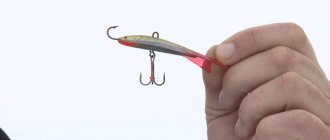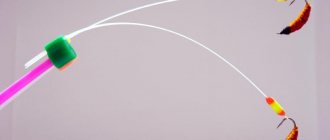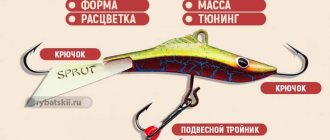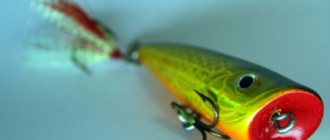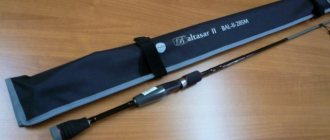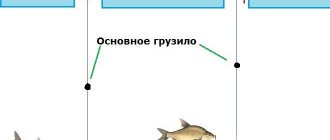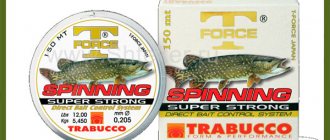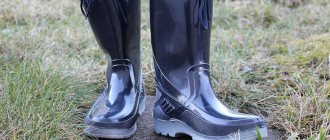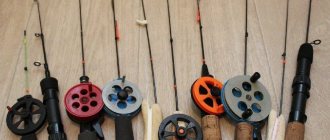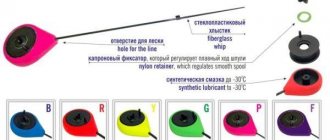A winter fishing rod for fishing with balance beams differs significantly from a traditional fishing rod for fishing with a jig in its dimensions, and it also has a handle.
In order to properly equip a fishing rod for vertical trolling, first, you must decide in what environment and what kind of fish you want to catch.
If there are large fish in the reservoir, for example, kilogram perch, pike perch or pike, you need to use stronger and more reliable fishing rods.
Basic requirements for a winter balance fishing rod:
- long (from 30 to 60 cm);
- durable to withstand pike and zander;
- comfortable and non-heat-conducting handle;
- quite light so that your hand does not get tired when wiring;
- hard whip 4-5 cm long.
Winter fishing rod for balancers – Salmo Pro Pike
For large fish, we recommend the Salmo Pro Pike winter fishing rod; it is well suited for fishing with a balance beam. The rod blank consists of high-modulus graphite, the guides and reel seat are very reliable. There is also an eyelet for attaching balancers and other baits. The weight of the fishing rod is only 54 grams. Withstands even trophy pikes.
Also a great winter fishing rod is the Salmo Pro Perch
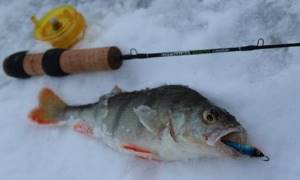
Fishing rod handle size and material
It was not for nothing that he said at the beginning that over time he would have to become self-made. A winter fishing rod for a balancer (and for other baits) is a conductor’s baton in your hands. It will be a foreign body - fishing is lost. Therefore, you will have to touch more than one model in the store.
We suggest you read: Catching carp with a float rod
What should you pay attention to? I won’t even say exactly what to put at the top of the list. Every feature of the handle is important.
The plastic handle is usually cold. In cold weather, and in the wind, playing with bait with your bare hand is inconvenient. I prefer foam or cork. Lightness and comfort in the hand.
It so happened that I almost always carry mittens or mittens in my pocket. Even if it’s minus 30 on the river. Therefore, I select handles exclusively for the “bare” hand. If this option is not suitable, then the size of the fishing rod handle should be commensurate with the grip in the mitten.
We also decide on the shape of the handle ourselves.
Can be summarized in one sentence. The fishing rod should lie in your hand without straining. I repeat - consider it a conductor's baton.
Features of a reel for a winter fishing rod
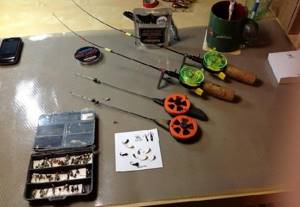
The thickness of the fishing line should be 0.12-0.18 mm (ideally 0.14-0.15 mm), and its quantity should be at least 50 meters. Since perch fishing is carried out at shallow depths, the fishing line must absorb the vibrations of a large fish, and in a certain situation the reel must release a piece of fishing line. Do not forget to reel in new fishing line before the start of each winter fishing season, otherwise you risk being left without gear.
Advantages and disadvantages of a balancer
This fishing equipment has its supporters and opponents.
- Most experienced fishermen agree that the advantages of a balancer include:
- Catching speed. You can catch several fish at once with one bait.
- Standardization . Suitable for any depth and other conditions of the water body.
- Convenience . There is no need to put bait on the fishing rod; you can fish without taking off your mittens.
- Variety . At the moment, there is a large amount of this equipment, each fisherman can choose the one that he likes best and is better suited for his purposes.

The disadvantage of this device is the removal of the catch from the hooks. Provided that the fish is caught intensively, it takes an inadmissibly long time to pull it out of the balancer.
Catch balancers

Kuusamo 50 balance beams for perch fishing appeared relatively recently among domestic fishermen, but have already taken their rightful place in fishermen’s boxes, having proven themselves to be very catchy. In some situations, they easily bypass vertical spinners. Quite often, it is possible to catch a perch with a balancer, the size of which exceeds the size of the “striper” that was caught with a spoon.
There are two types of balancers: with a soft wool tail and a plastic tail. Among the most popular balancer models are devices from Rapala (length from 30mm) and Kuusamo (50mm). Small balancers should be used at shallow depths; accordingly, large balancers are used in holes and depressions.
Fishing balancers for pike
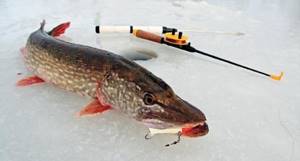
- Rapala Jigging Rap
- Scorana ICE Crystal
- Nils Master - Jigger
- Nils Master - Baby Shad
- Kuusamo Tasapaino 75
- Aqua balancers
- Karismax balancers
How many fishing rods do you need to master fishing with a balance beam?
At the moment, I definitely would not consider models with a nod in any of its manifestations. Although the warmest memories are associated with these fishing rods. And the first trophy perches were caught on them.
Once I’ve tried the no-knock approach at work, I have no desire to go back to the old way. Therefore, I recommend choosing a winter rod for fishing with a balancer exclusively without a hook. It may be more expensive, but it's worth it. The sensitivity of a fishing rod without a “tail” made of lavsan or metal is excellent.
Citizens, just don’t accuse me of being biased towards old models. A competent, and, more importantly, correctly equipped in all respects, nodding rod is a song. Here we are talking about the choice for an absolute beginner. It’s good if you find a smart fishing partner who will set everything up, show you, and tell you. And if not?
Selecting and adjusting the nod for the balancer will definitely make you worry. It will not be possible to make or buy a “universal” nod for all conditions. With one balancer it will work, with another it will hang like a sock, with the third it will be too stiff. The beskivkovka allows you to use many baits that fall within the characteristics of the six.
Don’t consider it an advertisement, take, for example, Lucky John Travel. This model has enough disadvantages. However, for such a budget there is one undeniable advantage - a working six. If for fishing on mebara grow culture 57 and Rapalovsky snap rep “four” you would have to select not only a nod, then on travel the noticeable weight dispersion of the balancers did not have much of an effect.
We invite you to familiarize yourself with: Rods for float fishing: carbon, match, where to buy, how to choose?
As for the length of the fishing rod, 45 - 50 cm is optimal. With this one, sitting on a box it is convenient to catch, from your knees and while standing. Short fishing rods seem to be comfortable and take up little space in the box. However, I know from myself that after fishing my neck and back don’t feel very good.
One could say that everything depends on the reservoir and its characteristics. The fish you plan to catch. But I won't tell. You shouldn’t count on a miracle that every fishing rod you take for fishing will be useful. If you have a strong desire to learn how to fish, then one fishing rod is enough.
The contenders for catching will definitely be perches. In most cases, they practice the technique of fishing with a balance beam. I can't recommend a specific model. Neptup knows what's going on in your stores. However, when purchasing, I recommend starting from baits up to 15 - 18 grams. This weight, as a rule, includes the main assortment of perch balancers. The rod of the fishing rod should not “fall through” under such weights. But don’t be a jerk either.
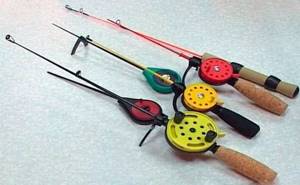
As for the balancers themselves, don’t overstock them. It is quite enough to have 2 - 3 models in a box, each in a pair of colors. Also skip “China”. It’s better not to spare money on branded balancers or state-owned units equivalent to them. For example, Lucky John balancers. Quite working baits at an adequate price.
I know that you can buy a lot of fishing trinkets on Aliexpress, but you shouldn’t do it. From experience I can say that the performance of those balancers is not even 50/50. Don’t go after cheapness. Ruin all the fun of fishing. Once you figure out what’s what, you’ll have your own accumulated experience - then you can decide for yourself whether to buy it or not.
Normund Grabovskis gave a good review of the range of winter fishing rods for fishing with balance beams and spinners from Team Salmo and Lucky John. There is no reason not to trust his words.
Usually in the arsenal of an experienced spinner there are several rods for fishing with a balancer of different calibers, for different weights of bait. Accordingly, the fishing line for balancers of different sizes differs in thickness. It is the weight of the bait used that primarily determines what equipment to put on the balancer.
On gear with a good reel and a flexible shock-absorbing whip, even when catching large fish, you can use fairly thin equipment. Fishing in this case can be done using a reel, using the American method. To catch pike in shallow water with a simple fishing rod with reels, it is better to use thicker, reliable monofilament, since a short fishing line (due to the shallow depth) will poorly absorb the jerks of large fish. An unbalanced tackle when catching a trophy specimen can lead to the loss of an expensive bait and a record-breaking fish.
Where to fish

Choosing the right place to fish for perch in winter is an integral part of successful fishing. Before identifying a fishing spot, very often you have to work by drilling several holes in the ice.
The thicker the ice becomes, the more difficult it is to determine the location of the perch, since, with the build-up of a block of ice, the fish moves to the middle of the reservoir and hides at depth in a snag. If you find a school, then fishing will be successful, although it often happens that after several fish are caught, the bite stops. In this case, you need to sprinkle the hole with snow and return to it a little later.
Ways to animate a balancer during winter perch fishing
Since perch is a predatory fish, it bites much better when actively playing with bait. In some cases, the bite occurs even with meaningless and chaotic movements of the tackle, but it will be much better if you use effective methods of play (Figure 5).
The following methods of balancing the balancer animation are considered the most effective:
- If the fish behaves passively, the bait is lowered to the bottom and then gradually raised to a meter height. Next, the balancer is released so that it smoothly sinks to the bottom, smoothly swaying from side to side. In this case, the abdominal tee is set in motion, which attracts the attention of the underwater predator. To increase the likelihood of a bite, after raising the bait to the recommended height, you need to lightly shake the tackle. Such movements are repeated 5-10 times and, if there are no bites, you can move on to the next hole.
- The second method is also suitable for fishing in the dead of winter, when the fish behaves passively. The balancer is smoothly lowered to the bottom again, and then sharply raised up 30 cm. Next, the rod is released so that the bait is in free fall. When it falls to the bottom again, you need to wait 3-5 seconds and repeat the procedure. If bites do not appear after 5-10 attempts, you can safely move on to the next hole.
- The third animation method is based on sharp rises of the balancer without lowering it. The range of raising the bait should be within 15-20 cm, and after each one you should pause for 5 seconds. Such movements should be made until the balance beam is directly next to the ice. As in previous cases, if there are no bites after several attempts, it is better to change the fishing location.
- During the thaw, the perch rises to the upper layers of the water. For fishing the upper horizon, there is a technique for animating the bait. In this case, the fish will react not so much to the play of the bait, but to the movements made by the lower tee. To animate it, you need to slightly twitch the rod. As a rule, if the place for fishing has been chosen correctly, the bites will not take long to arrive.
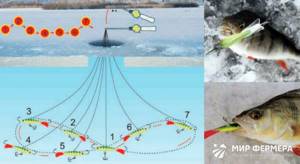
Some fishermen prefer to practice animating the balancer with a double rise without lowering. The balancer lowered to the bottom is first raised by 40 cm, a pause is made for 5 seconds, and again a sharp rise is made by another 40 cm, after which there is also a pause. If there is no bite after such a double rise, the bait is lowered to the bottom again.
How to fish with a balance beam
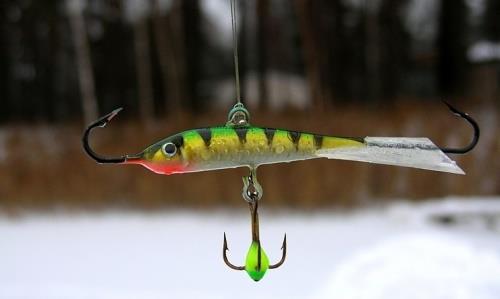
The game, when fishing with a balance beam, should be smooth, without sudden jerks. Depending on the model you choose, you yourself determine the duration of the pause.
And by looking into the hole, you can easily determine the operating time of the balancer. Don’t forget to time the time it takes for the bait to stop completely underwater. We recommend watching an interesting video that shows underwater filming of perch fishing with artificial bait.
Set of fishing rods
There can be as many rods equipped with balancers for perch in a fishing box as you like - at the discretion of the spinner. The most practical thing is three fishing rods of different constructions. They differ in the size of the balancers with which they are used. Accordingly, for heavy baits, prepare a more powerful tackle with a thick fishing line. There should also be a light version on hand - in case of passive fish, gentle bites on the rise and the predator’s interest in the smallest baits. Only fishing experience will help you specifically choose a winter fishing rod for a balancer on the spot depending on the bite; we can voice general requirements.

Main fishing rod
Of the three options offered, this one is average in terms of power and weight. Such a winter fishing rod for perch can be equipped with a 3-7 cm bait. A cheap Chinese lure with a built-in reel (or a 50-90 mm inertial reel) is also suitable as a fishing rod. However, preference should be given to high-quality carbon fiber, graphite or fiberglass fishing rods of medium hardness with a reel seat, vinyl or cork handle. Among these store-bought winter trolling rods, you should choose options with a soft and sensitive whip - in order to clearly feel the play of light lures in your hand. But we don’t need to break through the bony mouth of a pike perch from great depths. This tackle will be used most often; most of the fishing time and the swinging of the hole is done with its help (provided there is a good bite on baits of medium weight and size).
Heavy tackle
A coarser winter fishing rod for perch is used with baits of 5-9 cm when biting on large baits, as well as for shaking the hole during periods of high striped activity - at the beginning and end of winter. Wide and strong vibrations of a large balancer attract perch from a distance of 10-20 meters (depending on the purity of the water and the current).
For example, upon arriving at a reservoir (except in the middle of nowhere, when it is immediately better to use the medium or light option), the fisherman needs to start exploring the holes with this particular gear. If the bite starts, just continue to use this fishing rod. In case of frequent gatherings, uncertain bites, we switch to a medium fishing rod.
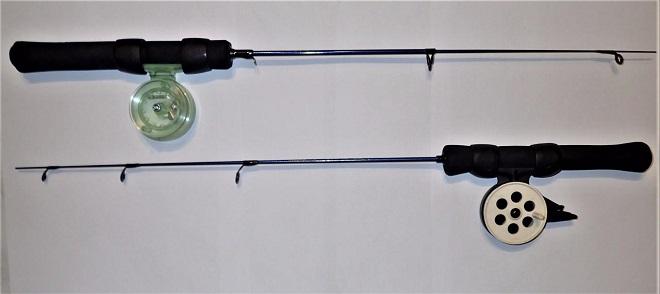
For such a fishing rod, you need to use stiffer rods so that the heavy bait does not fall through the whip. The correct balance of the whip and the weight of the bait is when the rod bends barely noticeably under its weight, and does not bend much when tossing. For this, light versions of pike perch or pike rods, special winter perch rods or homemade rods (for example, from a feeder quiver tip) are used. If on average tackle for perch it is more convenient to use a cheap plastic reel of 50-60 mm (or a reel in general), then a fairly powerful Chinese one, 90 mm, special for winter lures, or a 1000 spinning reel is more useful here. This is not for everybody. A large predator may covet a large bait, and you need to be prepared for this.
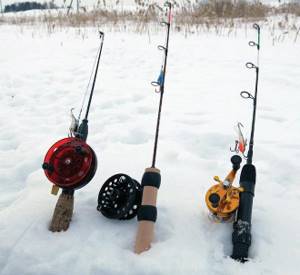
Lightweight
Winter perch ultralight helps out when the bite is bad and when the striped fish reacts only to ultra-light baits, up to 3 cm. This fishing rod is elegant and light, sensitive to the most gentle bite on the rise. For this tackle you need to use light lures with a reel. Lately, a homemade light fishing rod made from an ordinary winter balalaika, where instead of the original one, a whip from a summer rod 50-60 cm long is attached, is becoming increasingly popular. Such a tip costs a penny in a fishing store. The design is light and long, which gives a fairly large lever. That is why this tackle is so sensitive. The fishing line is passed from the balalaika inside the whip (to do this, during manufacture, a through hole must be drilled in the socket for the reel in the reel body).
